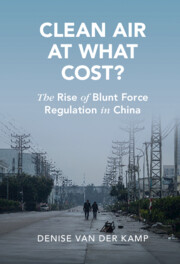Book contents
- Clean Air at What Cost?
- Cambridge Studies in Law and Society
- Clean Air at What Cost?
- Copyright page
- Dedication
- Contents
- Figures
- Tables
- Acknowledgments
- Abbreviations
- Chapter 1 Introduction
- Chapter 2 Blunt Force Regulation
- Chapter 3 Why Blunt Force Regulation?
- Chapter 4 Blunt Force Regulation and Bureaucratic Control
- Chapter 5 The Impact of Blunt Force Regulation
- Chapter 6 What Are the Alternatives?
- Chapter 7 Managing the Risks
- Chapter 8 Comparative Implications
- Chapter 9 Conclusion
- Appendix
- Bibliography
- Index
- Cambridge Studies in Law and Society
Chapter 8 - Comparative Implications
Published online by Cambridge University Press: 28 January 2023
- Clean Air at What Cost?
- Cambridge Studies in Law and Society
- Clean Air at What Cost?
- Copyright page
- Dedication
- Contents
- Figures
- Tables
- Acknowledgments
- Abbreviations
- Chapter 1 Introduction
- Chapter 2 Blunt Force Regulation
- Chapter 3 Why Blunt Force Regulation?
- Chapter 4 Blunt Force Regulation and Bureaucratic Control
- Chapter 5 The Impact of Blunt Force Regulation
- Chapter 6 What Are the Alternatives?
- Chapter 7 Managing the Risks
- Chapter 8 Comparative Implications
- Chapter 9 Conclusion
- Appendix
- Bibliography
- Index
- Cambridge Studies in Law and Society
Summary
This chapter broadens the scope of the analysis to assess whether blunt force regulation is unique to China. It reveals that blunt force regulation is a widespread political phenomenon found in both advanced industrial environments (like the UK) and weak institutional environments (like India and the Philippines). When political leaders confront urgent or overwhelming enforcement problems, they sometimes resort to unreasonable, one-size-fits-all measures to ensure that enforcement actions are effective. Through analyzing these cases, this chapter concludes that blunt force regulation is one of a set of potential responses to the inevitable principal–agent problems of regulation. However, the character of blunt force regulation – including how forceful or indiscriminate it is – is shaped by institutional features such as a state’s resource capabilities and coercive capacity.
Keywords
- Type
- Chapter
- Information
- Clean Air at What Cost?The Rise of Blunt Force Regulation in China, pp. 160 - 182Publisher: Cambridge University PressPrint publication year: 2023

